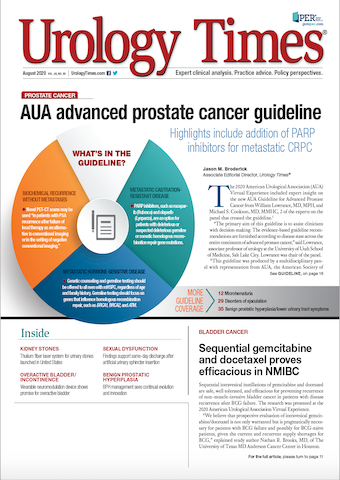Publication
Article
Urology Times Journal
Treatment alternatives to radical cystectomy for bladder cancer continue to evolve
Author(s):
"Therapeutic strategies are needed in the management of NMIBC that recurs after gold-standard intravesical BCG," Gomella writes.
Non–muscle invasive bladder cancer (NMIBC) often responds to induction and maintenance BCG when doctors are treating intermediate- and high-risk disease. The NMIBC guidelines issued by
Leonard G. Gomella, MD

the American Urological Association (AUA) favor radical cystectomy in patients with high-risk disease who have failed induction or maintenance courses of BCG. For low- and intermediate-risk disease, further therapies are indicated before radical cystectomy should be used. Although the initial response to BCG can be as high as 70%, the lack of benefit after 2 induction courses of BCG increases the risk of disease progression. In these cases, alternatives to radical cystectomy are desirable.
Brooks et al reported on a multi-institution intravesical chemotherapy trial at the 2020 AUA Virtual Experience in June (see article). In high-risk patients who failed BCG, Brooks and colleagues used sequential intravesical instillations of gemcitabine (Gemzar) and docetaxel (Taxotere). The recurrence-free survival in the primary analysis was 60% at
1 year and 46% at 2 years. Nearly two-thirds of the patients enrolled were cystectomy candidates on the basis of current guidelines.
Numerous intravesical monotherapy chemotherapy studies have been published with limited data on combining intravesical chemotherapies. Intravesical mitomycin (Mitosol) is well established as a single intravesical administration following resection of low-risk NMIBC and as an alternative to BCG induction and maintenance. Epirubicin (Ellence) has been used but is inferior to BCG. Valrubicin and thiotepa (Tepadina) are the only officially FDA-approved intravesical chemotherapy agents for bladder cancer, with toxicity often limiting their use. Monotherapy studies on the use of docetaxel are limited.
There are robust data on the use of intravesical gemcitabine. The SWOG S0337 (NCT00445601) trial randomized immediate posttransurethral resection of the bladder tumor with intravesical instillation of gemcitabine vs saline in patients with NMIBC. When used post resection, gemcitabine significantly reduced the risk of recurrence over a median of 4 years with an excellent safety profile. Another study, however, failed to confirm the recurrence benefit, but both indicated a good safety profile.
Combination and sequential immunotherapies have been used previously, such as BCG with interferon, with mixed results. This 2020 study sequencing 2 chemotherapies (gemcitabine and docetaxel) is 1 of the first to report a benefit for the combination of intravesical agents. These medications are normally administered systemically and require specific monitoring. The intravesical route, with limited absorption compared with other intravesical chemotherapy agents, minimizes systemic toxicity.
Another area of interest in NMIBC that is based on the legacy of the effectiveness of BCG continues to be immunotherapy. Systemic pembrolizumab (Keytruda) is approved for patients who are ineligible for cystectomy. Many other intravesical and systemic immune modulatory agents are in the late stages of development, such as the novel gene-mediated therapy nadofaragene firadenovec, for intravesical administration.
Not all patients respond to or can tolerate BCG immunotherapy. Therapeutic strategies are needed in the management of NMIBC that recurs after gold-standard intravesical BCG. The worldwide BCG shortage is also a reason to investigate alternative bladder cancer therapies. Although immunotherapy approaches to NMIBC are rapidly moving ahead, new approaches to intravesical chemotherapy, such as the combination of agents, are also proving to be useful in fighting this disease.
Gomella, a member of the Urology Times® Editorial Council, is professor and chair of urology at Thomas Jefferson University, Philadelphia, Pennsylvania.
































